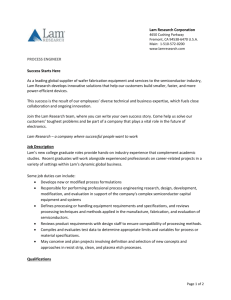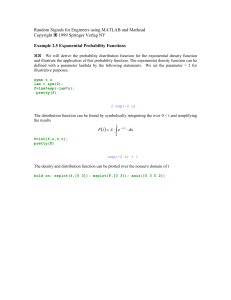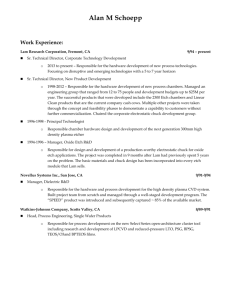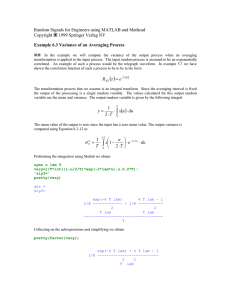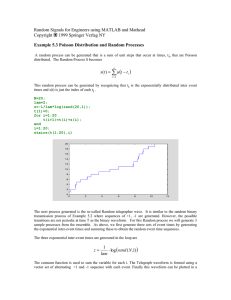Careers for Physicists, Scientists, and Engineers in
advertisement
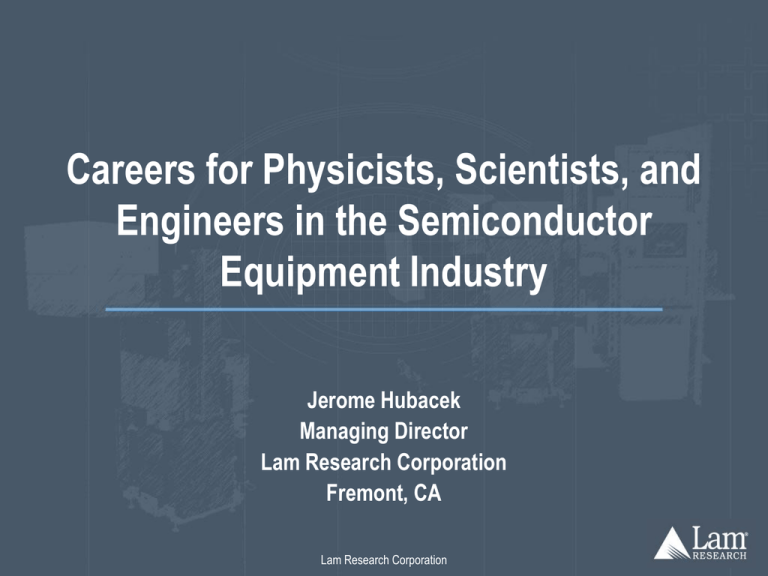
Careers for Physicists, Scientists, and Engineers in the Semiconductor Equipment Industry Jerome Hubacek Managing Director Lam Research Corporation Fremont, CA Lam Research Corporation Careers in the Semiconductor Equipment Industry Introduction to the Semiconductor Equipment Industry Career opportunities Profile of the successful employee Transitioning from Graduate School to the Semiconductor Equipment Industry Keys to success (v7) Slide - 2 Lam Research Corporation Introduction to the Semiconductor Equipment Industry (v7) Slide - 3 Lam Research Corporation Semiconductor Technology Continues to Drive New Capabilities Power Management NAND Flash Graphics Engine Multi-core CPU (v7) Slide - 4 Lam Research Corporation Market for Wafer Fabrication Equipment (WFE) Five Major Markets Quad Processor “Barcelona” (AMD) Electronic Equipment (2010) $1,485 Billion Computing Automotive Consumer Communication Semiconductors $298 Billion Industrial/ Military 16 Gbit 50 nm NAND Flash Buildings, Computers, and Equipment 1 Gbit 78 nm DRAM (Micron) Capital Spending $57 Billion WFE $29B Dry etch is ~13% of WFE spending Lam Research has >50% etch market share Single-wafer cleaning is ~4% of WFE Lam Research has >25% market share Source: Dataquest, Lam Research internal (v7) Slide - 5 Lam Research Corporation Semiconductor Equipment Manufacturer Revenues Rank 2006 2007 2008 2009 2010 1 Applied Materials Applied Materials Applied Materials Applied Materials Applied Materials 2 Tokyo Electron Tokyo Electron ASML ASML ASML 3 ASML ASML Tokyo Electron Tokyo Electron Tokyo Electron 4 KLA-Tencor KLA-Tencor KLA-Tencor KLA-Tencor Lam Research 5 Lam Research Lam Research Lam Research* Lam Research KLA-Tencor 6 Nikon Nikon Nikon Nikon Dainippon Screen 7 Novellus Systems Novellus Systems Dainippon Screen Dainippon Screen Nikon 8 Dainippon Screen Dainippon Screen Hitachi High-Tech Novellus Systems Novellus Systems 9 Canon Hitachi High-Tech Novellus Systems Aixtron Aixtron 10 Hitachi High-Tech Varian Canon Hitachi High-Tech Varian Lam acquisition of Novellus projected to close in Q2 2012 (v7) Slide - 6 Lam Research Corporation * Includes SEZ AG, acquired 2008 Source: Gartner Dataquest (v7) Slide - 7 Lam Research Corporation Visualizing Moore’s Law 2x Shrink Die 2x Shrink Transistor (v7) Slide - 8 Lam Research Corporation Moore’s Law Has Evolved Over Time 1010 Today: The number of transistors per die doubles every 24 months 109 Duo Transistors per Die 108 i7 Pentium III Atom™ Pentium II 107 106 Pentium I486™ 105 104 8086 103 4004 100 I286™ I386™ 8080 Intel® Microprocessors 10 1 1960 1970 1980 Source: Gordon Moore, ISSCC 2003 & Intel 2010 (v7) Slide - 9 Lam Research Corporation 1990 2000 2010 Implications of Moore’s Law: Higher Performance, Lower Cost $1 $0.01 Dollars $0.001 $0.0001 $0.00001 $0.000001 1970 1980 1990 2000 DRAM Device Speed Memory Bandwidth Price per Transistor $0.1 DDR3-1066 DDR2-800 DDR2-667 DDR-400 DDR2-533 DDR-333 DDR-226 2000 2002 2004 2006 As transistor size gets smaller, everything gets better Transistor Cost Transistors Power Usage Transistor Speed (v7) Slide - 10 Lam Research Corporation Transistors per Square Inch 2008 Equipment Solutions must be ahead of customer needs to meet roadmap 250 Critical Dimension (CD) 180 CD control required by ITRS Roadmap Technology Node (nm) 130 90 65 Customer A Roadmap 45 32 Lam Research Roadmap 22 14 1998 (v7) Slide - 11 2001 2004 2007 Lam Research Corporation 2010 2013 2016 Predicting the End of Moore’s Law: Historical Perspective Materials Limitations: Device Physics Limitations: “Copper is an intractable material. The reason we don’t use copper is NOT because we haven’t tried over the years.” “…we get to 0.05 micron [50 nm] in something like 2017…so that’s the end of Moore’s Law!” Lithography Limitations: “[For lithography] to go down to 0.10 micron [100 nm]… there’s hardly anything left at 193nm [wavelength]” Uncertainty around the extendibility of Moore’s Law has always existed Source: “Moore’s Law extended: The return of cleverness”, Solid State Technology, July 1997 (v7) Slide - 12 Lam Research Corporation Continuous Innovation Enables Continuation of Moore’s Law 1.00 W Plug 0.8 CMP 200 mm 0.5 STI Micron 248 nm 0.35 CoSi2, SiOF Lithography Enablers 0.25 0.18 Copper 0.13 193 nm 300 mm 90 nm NiSi, Strain, Low-k 65 nm Phase shift High-k, Metal Gate 45 nm (immersion) 0.10 Strain, SiGe Technology Enablers Tri-gate (3D) 28 nm Double/Quad Patterning 14 nm EUV 0.01 1980 (v7) Slide - 13 1985 1990 1995 2000 2005 Lam Research Corporation 2010 2015 2020 Technology Inflections Enabling Continuation of Moore’s Law Logic/Foundry: 2D to 3D architecture FinFET structures at 20-14 nm – Additional metal layers in back-end-of-line (BEOL) Drain – Gate Gate Source Planar MOSFET FinFET Flash: 2D to 3D architecture – New architectures likely introduced at the mid-to-low 1x node Planar NAND Vertical NAND Multiple patterning: Foundry leaders: DPT starting at 22 nm – Memory leaders: increasing DPT layers and going beyond double patterning – (v7) Slide - 14 Litho-Only Patterning Lam Research Corporation Double Patterning (DPT) Quadruple Patterning Materials Used in Semiconductor Devices in the 1980’s IA VIIIA H IIA IIIA IVA VA VIA VIIA He Li Be B C N O F Ne Al Si P S Cl Ar Ni Cu Zn Ga Ge As Se Br Kr Na Mg IIIB IVB VB VIB VIIB [------- ---VIII--- -------] V Cr Mn Fe Co IA IIA K Ca Sc Ti Rb Sr Y Zr Nb Mo Tc Ru Rh Pd Ag Cd In Sn Sb Hf Tl Pb Bi Po Cs Ba Ta W Re Os Ir Pt Au Hg Te I Xe At Rn Fr Ra La Ce Pr Nd Pm Sm Eu Gd Tb Dy Ho Ac Th Pa U Np Pu Am Cm Bk Cf Er Tm Yb Lu Es Fm Md No Lr Source: ITRS 2005, Lam Research Materials used in the 80s (v7) Slide - 15 Lam Research Corporation Materials Used in Semiconductor Devices in the 1990’s IA VIIIA H IIA IIIA IVA VA VIA VIIA He Li Be B C N O F Ne Al Si P S Cl Ar Ni Cu Zn Ga Ge As Se Br Kr Na Mg IIIB IVB VB VIB VIIB [------- ---VIII--- -------] V Cr Mn Fe Co IA IIA K Ca Sc Ti Rb Sr Y Zr Nb Mo Tc Ru Rh Pd Ag Cd In Sn Sb Hf Tl Pb Bi Po Cs Ba Ta W Re Os Ir Pt Au Hg Te I Xe At Rn Fr Ra La Ce Pr Nd Pm Sm Eu Gd Tb Dy Ho Ac Th Pa U Np Pu Am Cm Bk Cf Er Tm Yb Lu Es Fm Md No Lr Source: ITRS 2005, Lam Research Materials in the 80s (v7) Slide - 16 Materials added in the 90s Lam Research Corporation The Next Challenge – Growth in Potential New Materials Etching and cleaning vastly different materials IA VIIIA H IIA IIIA IVA VA VIA VIIA He Li Be B C N O F Ne Al Si P S Cl Ar Ni Cu Zn Ga Ge As Se Br Kr Na Mg IIIB IVB VB VIB VIIB [------- ---VIII--- -------] V Cr Mn Fe Co IA IIA K Ca Sc Ti Rb Sr Y Zr Nb Mo Tc Ru Rh Pd Ag Cd In Sn Sb Hf Tl Pb Bi Po Cs Ba Ta W Re Os Ir Pt Au Hg Te I Xe At Rn Fr Ra La Ce Pr Nd Pm Sm Eu Gd Tb Dy Ho Ac Th Pa U Np Pu Am Cm Bk Cf Er Tm Yb Lu Es Fm Md No Lr Source: ITRS 2005, Lam Research Materials in the 80s (v7) Slide - 17 Materials added in the 90s Lam Research Corporation Materials added or evaluated since 2000 The Edge of the Wafer Plays a Critical Role in Overall Economics ~3% of chips ~10% of chips More good chips = More $$$$$ ~25% of chips ~55% of chips outside radius (v7) Slide - 18 Lam Research Corporation What variables define the available process space? - Etch Example List of Process Variables (# different settings that can change the result on a wafer) – – – – – – – – – (v7) Pressure (10mT, 20mT, … 100mT) = 10 settings Reactant Gas #1 flow rate (0sccm, 10sccm, 100sccm) = 10 Reactant Gas #2 flow rate (0sccm, 1sccm, 10sccm) = 10 … Reactant Gas #16 flow rate (0sccm, 100sccm, 500sccm) = 5 Power @ frequency #1 (0W, 100W, …, 3000W) = 30 Power @ frequency #2 (0W, 50W, …, 500W) = 10 Power @ frequency #3 (0W, 100W, …, 1000W) = 10 … 10 x 10 x 10 … x 5 x 30 x 10 x 10 x … = 10(really big number) Slide - 19 Lam Research Corporation Now add in hardware and wafer variables… Process Variables (different settings that can change the result on a wafer) – Pressure (10mT, 20mT, … 100mT) = 10 settings – Reactant Gas #1 flow rate (0sccm, 10sccm, 100sccm) = 10 – Reactant Gas #2 flow rate (0sccm, 1sccm, 10sccm) = 10 – … – Reactant Gas #16 flow rate (0sccm, 100sccm, 500sccm) = 5 – Power @ frequency #1 (0W, 100W, …, 3000W) = 30 – Power @ frequency #2 (0W, 50W, …, 500W) = 10 – Power @ frequency #3 (0W, 100W, …, 1000W) = 10 – … Technology Node (µm) Hardware variables 10 1 0.1 Source: Chipworks 2006, Intel Website 0.01 1972 – Chamber diameter Moore’s Law 1982 1992 2002 2012 – Chamber temperature – Wafer temperature – Chamber materials chemical properties – Chamber materials electrical properties – … Wafer variables – Material being etched – Type of mask (photoresist) – Percent exposed area of wafer being etched Number of Recipes – Chamber heights 1E+14 1E+10 “Gottscho’s Law” 1E+06 1E+02 1972 – Substrate resistivity – … (v7) Slide - 20 Lam Research Corporation 1982 1992 2002 2012 How Can We Possibly Pick “One in a Trillion” (v7) Learn from past experience (Knowledge Management). Use modeling to help narrow the space. Use sensors, diagnostics and “smart” software. Hire really smart and motivated people. Run lots of experiments. Slide - 21 Lam Research Corporation Semiconductor Equipment Industry Career Opportunities (v7) Slide - 22 Lam Research Corporation Semiconductor Equipment Industry Jobs Design/Hardware Engineer: Creates the knobs Supplier Engineer: Develops suppliers to make the knobs Process Engineer: Determines what knobs are needed and turns the knobs to optimize for customer applications Product Engineer: Optimizes the knobs Field Engineer: Solves problems with the knobs on site Technical background and industry experience are required for many product development functions including Technical Marketing, Product Management, Supplier Business Management (v7) Slide - 23 Lam Research Corporation Semiconductor Equipment Industry Employee Profile (v7) Slide - 24 Lam Research Corporation Semiconductor Equipment Industry: Employee Profile Majors: – – – – Physics Chemistry Engineering (Electrical, Chemical, Mechanical, Materials Science) Computer Science Education: PhD, MS, BS Lam Research Statistics – – – – Total Employees: >3800 Advanced Degrees: ~1200 PhD’s: ~400 UIUC Grads: 21 (13 PhD’s) Advanced degrees with experimental experience are preferred – Direct semiconductor experience is NOT required – Strong foundation in coursework and experimental work (wafer processing, vacuum, low temp, plasmas, metrology, transport measurements, optics, etc.) – Design, Simulation, and Modeling experience (CAD, FEA, CFD, plasmas, etc.) – Managing research projects (budget, plan, and build experimental setups, write proposals) (v7) Multi-cultural: Semiconductor Equipment is a global industry Slide - 25 Lam Research Corporation Lam Research Global Support – Close to Our Customers Northwest Idaho, Washington Germany Northeast Dresden New York Switzerland France Corp. Headquarters Arizona, Texas Beijing, Shanghai, Wuhan, Wuxi Schiphol-Rijk Dublin Central China The Netherlands Ireland Corbeil Essonnes, Meylan, Rousset Neuchatel Italy Agrate Austria Villach Israel Korea: Ramat Gan Malaysia Fremont, CA Livermore, CA Japan Hiroshima, Kumamoto, Shin-Yokohama, Toyama, Yokkaichi Bundang, Cheongju, Hwaseong, Icheon Taiwan Singapore (v7) Slide - 26 Lam Research Corporation Gueishan, Houli, Hsinchu, Taichung, Tainan Transitioning from Grad School to the Semiconductor Equipment Industry (v7) Slide - 27 Lam Research Corporation Similarities b/w Grad School and the Semiconductor Equipment Industry Have a passion for what you do – you are going to be doing it for a long time – Time from entering college to graduation with a PhD: ~8-11 years – Time in your career: >>20 years Learn at every opportunity – On the job, in the lab, coursework, outside reading, seminars Communication is critical – Good ideas can go to waste if not properly communicated – Confront small issues before they get big Hard work is necessary to maximize your opportunities – “The more you practice, the luckier you get.” You have very few customers – treat them well – Grad School: Your advisor, your professors, colleagues – Industry: 70% of capital equipment purchases are made by 10 customers (v7) Slide - 28 Lam Research Corporation Differences b/w Grad School and the Semiconductor Equipment Industry The product is different (How you keep score) – Grad school: Teaching, learning (grades), papers, grants (Publish or Perish) – Industry: Selling goods and services for profit (Profit or Perish) The approach is different – Grad school: Learning on the job mistakes are expected and ok (as long as you learn from them); nothing is “beneath” you; prove a concept – Industry: Mistakes must be minimized; employees work on things at or above their grade level; prove in production The customer is different – Grad school: Work is directed by advisors, professors, and funding agencies based on broad guidelines; students are the primary users of experimental equipment – Industry: Work is dictated by shareholders, markets, competition, and detailed customer requirements; customers (operators) are the primary users of the equipment Not allowed: “Designed by PhD’s for PhD’s” The milestones are different – Grad school: Milestones are based on exam dates, graduation dates, conferences – Industry: Milestones are customer and finance driven; patents are part of development (v7) The money is different Slide - 29 Lam Research Corporation Lam Research Continues to Invest Through the Cycles Revenue of $2.8B in CY 2011 More than $1B invested in R&D over last three years R&D investment continues through downturns Moore’s Lam holds through cycles Revenue R&D Millions Millions $400 $3,000 SEA $2,500 China $2,000 Taiwan $350 $300 $250 Korea $1,500 Japan Europe $1,000 N. America $500 $200 $150 $100 $50 $0 2006 (v7) Slide - 30 2007 2008 2009 2010 2011 Lam Research Corporation $0 2006 2007 2008 2009 2010 2011 Keys to Success in the Semiconductor Equipment Industry (v7) Slide - 31 Lam Research Corporation Keys to Success in the Semiconductor Equipment Industry Solve problems systematically – Know what problem you are trying to solve (Listen carefully) – Involve all stakeholders in the process – Know what success looks like – Determine the root cause and consider all solution options – Implement the solution and make sure it sticks (v7) Set aggressive targets for yourself and achieve them Make data-driven decisions Be a leader, not a “status-er” Be a simplifier, not a complicator know when to focus Communicate openly (up, down, left, and right) and ask for help before the situation is irresolvable (no surprises) Demonstrate Versatility, Flexibility, and Agility (if business changes, you adapt) Demonstrate Core Values Remember that the customer is always right** And….. Slide - 32 Lam Research Corporation Be The results… Conductor Etch 2300® Kiyo® Product Family MEMS & Deep Si Etch TCP® 9400DSiE™ Product Family Dielectric Etch 2300® Flex™ Product Family Spin Wet Clean Metal Etch TSV Etch for 3-D IC 2300® Versys® Metal Product Family 2300® Syndion® Linear Wet Clean Plasma Bevel Clean 2300® Serene® 2300® Coronus® DV-Prime™ … technology driven products enabling Moore’s Law. (v7) Slide - 34 Lam Research Corporation Acknowledgements (v7) Professor Lance Cooper for giving me the opportunity to speak today Dave Hemker, Lam VP of R&D, for many of the introductory slides Jim Bagley, Lam Chairman, for excerpts from his “Top 10 things a manager should do” presentation Steve Newberry and Martin Anstice, former and current Lam CEO’s, for excerpts from the “Lam Problem Solving and Decision Making Process” Lam Corporate Marketing Team for Lam and industry overview slides Slide - 35 Lam Research Corporation Lam Research at a Glance Major supplier of wafer fab equipment and services – Headquartered in Fremont, California, with facilities in Asia, Europe, and North America – ~3,850 Employees worldwide – Revenue of $2.8B in CY 2011 Etch and Clean product lines offer leading technologies for performance and extendibility – Conductor, dielectric, MEMS, deep silicon, and through-silicon via (TSV) etch – Wet and plasma-based single-wafer clean (v7) Customer Support Business Group (CSBG) dedicated to optimizing installed equipment performance and operational efficiency Slide - 37 Lam Research Corporation Lam Research: Mission, Vision, and Core Values Mission: Lam Research is dedicated to the success of our customers by being a world-class provider of innovative productivity solutions to the semiconductor industry. Vision Objectives: #1 in customer trust Achievement #1 in market share Ownership and accountability A company where successful people want to work Mutual trust and respect Honesty and integrity A multi-product company Innovation and continuous improvement Financial performance appropriate to: Open communication Teamwork Think: customer, company, individual – Support the productivity solutions our customers require – What our shareholders expect (v7) Core Values: Slide - 38 Lam Research Corporation Rainbow® Etch Series Invented spin technology for single-wafer clean Transformer Coupled Plasma™ based products for silicon and metal etch Alliance® cluster tool platform for etch Slide - 39 2015 2010 2005 Shipped 7,500th etch process module for the 2300® platform Dual Frequency Confined™ technology for dielectric etch First product, AutoEtch (v7) 2000 1995 1990 1985 1980 Lam Research Product & Technology Milestones Shipped 3,000th single-wafer spin clean process module 2300® platform offers first 200 mm/300 mm capability Da Vinci® spin clean platform 2300® Exelan® Flex™ & 2300® Versys® Kiyo® for dielectric & conductor etch 2300® Flex™ D Series dielectric etch system 2300® Kiyo® C Series conductor etch system DV-Prime® next-generation spin clean system 2300® Coronus® plasma bevel clean system 2300® Syndion® system, first 300 mm TSV etch Lam Research Corporation Next-generation 2300e4® & 2300e5® platforms Lam Research – Where Successful People Want to Work Company Leadership Advancing semiconductor manufacturing for more than 30 years Market share leader Financially sound Operations excellence Open and collaborative environment that fosters innovation Experienced management team with proven record of success Lam’s senior management recognized among the best leaders in the industry Technology experts in Etch and Clean Local management in each region Employees Community Experienced, talented, and dedicated global workforce (v7) Extension of the Company’s Core Values into our employees’ communities Multi-cultural and diverse Actively demonstrate Lam’s Core Values Cross-functional teams work in collaborative environment 75% of promotions from within the Company Slide - 40 Lam Research Foundation grants Core Values Scholarship program Employee gift/volunteer time matching Food drive, toy drive, blood drives, and other outreach activities Lam Research Corporation Lam Research Is #1 in Etch Shipped Market Share 60% 2007 2008 2009 2010 Lam Research Lam Research Lam Research Lam Research 2 Tokyo Electron Tokyo Electron Tokyo Electron Tokyo Electron 3 Applied Materials Applied Materials Applied Materials Applied Materials 1 4 Hitachi Hitachi Hitachi Hitachi 50% Shipped Market Share Rank 40% 30% 20% 10% 0% 2008 2009 2010 Lam Research surpassed 50% market share in 2010 Source: Lam Research Corp. (v7) Slide - 41 Lam Research Corporation
